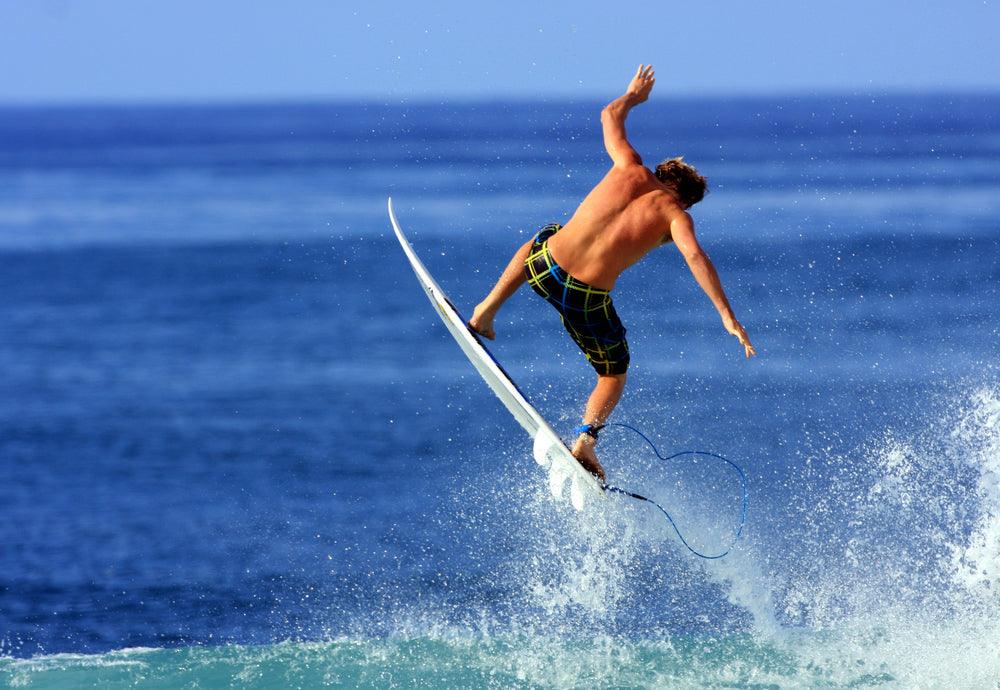
You’ve probably noticed that there are fins on the bottom of a surfboard, but have you ever wondered what they do? Surfboard fins are important for the control of the surfboard and improving its performance through the water.
Why Do Surfboards Have Fins?
Surfboard fins help with several things:
- They alter the drive and speed of the board in the water
- They affect how well a surfboard handles in the water, in particular when turning
- They change how the board feels on waves
When a surfboard is in the water there are two main forces that are acting on it. They are lift and drag. The size and shape of the fins alter how powerful those forces are. Finding the perfect handling for your surfboard means finding the right balance between lift and drag.
There is no single ‘correct configuration’. What works for one person may not work for another. It all depends on the type of board you have, the waves you are surfing in, and your own surfing style and ability.

Understanding Lift
Lift is a force that acts perpendicular to the board. Surfboard fins produce horizontal lift that can be used to build speed, helping you make turns more effectively. If you don’t have enough lift, you’ll find yourself sliding in turns.
Fins with different sizes, thicknesses and surface areas will produce different amounts of lift at different speeds. When you increase lift, you also increase drag. If you have no fin or a very small fin, you’ll have very little drag but also very little lift. Bigger fins add lift, but also add drag.
Note that while people tend to refer to fins as producing vertical lift, this is a bit of a simplification. Fins really produce lateral lift, and the greater the cant of the fin, the greater the lift since more of the fin is exposed to the wave. This is how a fin prevents a surfboard from sliding out during a turn.
When water surges against a fin in the middle of a turn, the surfer should feel some acceleration. This is because the fins are producing drive. So, as the surfer lays into the turn, the water applies pressure against the fin, accelerating the board out of the turn.
Choosing A Fin
Every board design is different. Some boards are created in a way that means you can ride them fairly well without having to worry about adding a fin for lift. Other boards are almost impossible to control through turns if they don’t have a substantial fin.

As a rule of thumb, if you feel that there isn’t enough lift on your board, you’ll need to make the fin thicker. If you feel that there’s too much drag, you’ll need to make the foil thinner.
There are some techniques you can use to maximise lift without increasing drag too much:
- Use a fin with a rounded leading edge
- Choose a fin that twists, instead of bends, towards the tip
The main characteristics of a surfboard fin are:
- Base – the length of the fin where it meets the board
- Depth – how far the fin penetrates the water
- Flex – how much the fin bends
- Template – the shape of the fin
- Sweep – how far the fin curves backward, in degrees
- Toe angle – the angle of the side fins compared to the stringer
- Cant – The angle the fin leans away from the bottom of the board
- Foil – symmetrical or asymmetrical
- Angle of attack – the angle of the fin in relation to the water
Changing any one of these characteristics will impact how the board moves in the water and how easy it is to control. Therefore, it’s important to take all of these things into consideration when not just choosing the type of fins you want for your surfboard, but also the configuration.
At Beachin Surf, you can find the best fins for your surfboard with our huge range of surfboard accessories. Please feel free to come and visit our shop at 262 Maine Road, Toukley, NSW. We will be happy to show you around and assist you in finding the best fins for your surfboard.
Please call us today on (02) 4396 5159 or send us an inquiry.
